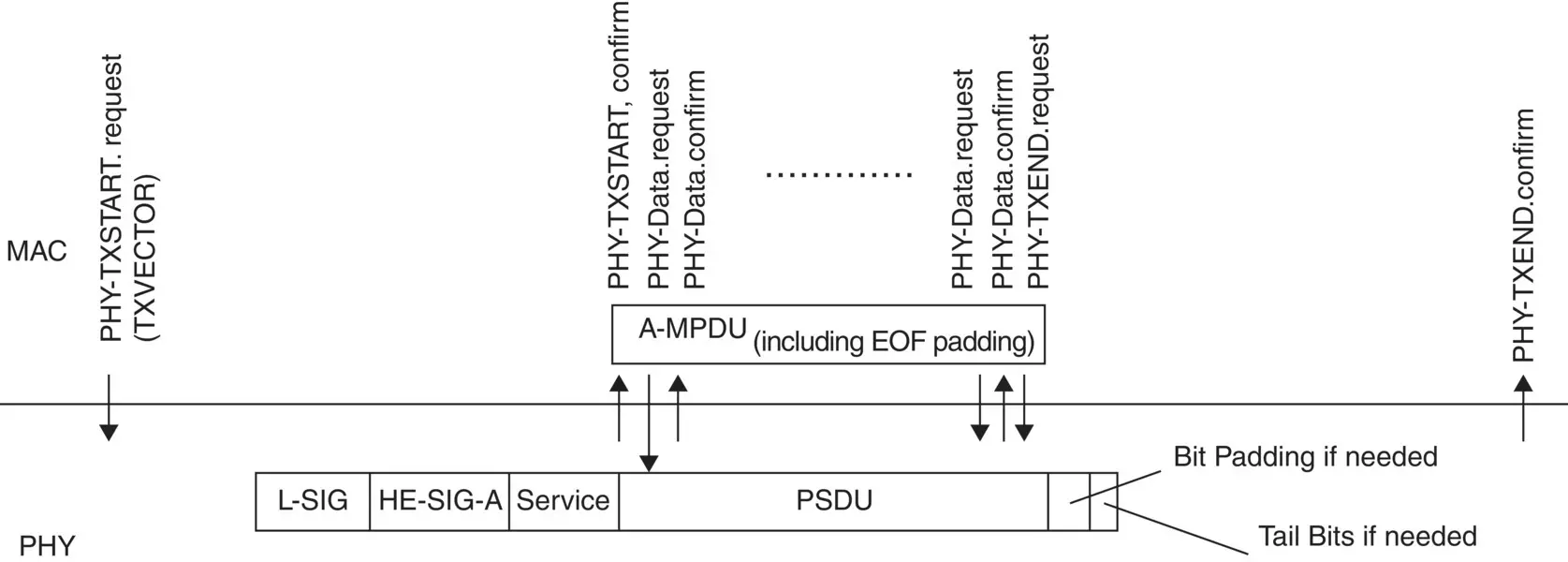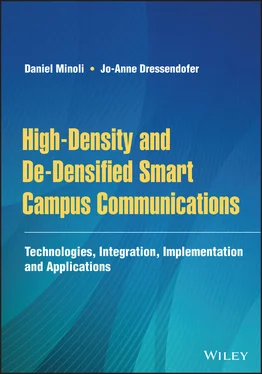The PHY entity is based on OFDM or OFDMA. OFDM is a type of digital modulation that uses frequency‐division multiplexing (FDM) principles. The method subdivides an RF channel into a large number of contiguous subchannels to provide reliable high‐speed communications. All subcarrier signals within a subchannel are orthogonal to one another. The subcarrier frequency signals that are being modulated are selected such that the subcarriers are orthogonal to each other whereby cross‐talk between the subchannels is minimized or eliminated; note that inter‐carrier guard bands are not needed. OFDM transmitters and receivers are relatively simple; in particular, a separate filter for each of the subchannel is not required. Modulation is achieved by encoding signals on multiple carrier frequencies. In this scheme, multiple closely spaced orthogonal subcarrier signals with minimally overlapping spectra are transmitted such that they can carry information in parallel. Each individual subcarrier signal can be modulated with a traditional modulation scheme at a low symbol rate, for example, using Quadrature Amplitude Modulation (QAM). Demodulation utilizes Fast Fourier Transform (FFT) methods. While the total data rates in an OFDM scheme are generally similar to conventional single‐carrier modulation in the same aggregate bandwidth, the key advantage of OFDM over single‐carrier schemes is its ability to function in environments with challenging channel conditions, for example, with attenuation of high frequencies components in a cable, and with channel interference including fading due to multipath reflections. OFDM is broadly deployed for wideband digital communication, including digital television, Digital Subscriber Line (DSL) internet access, wireless networks, and 4G/5G mobile communications.
OFDM, in its basic form, is a digital modulation technique being employed for transferring a data stream from a single user over an aggregate communication channel, utilizing a sequence of OFDM symbols. Nonetheless, OFDM can be combined with multiple access techniques to support multiple users utilizing time, frequency, or coding separation of the various users. In OFDMA, Frequency‐Division Multiple Access (FDMA) is achieved by assigning different OFDM subchannels to different users. IEEE 802.11ax WLANs utilize OFDMA for high‐efficiency and simultaneous communication; OFDMA is also used in wide‐area applications including but not limited to WiMAX, 3GPP LTE 4G mobile broadband standard DL, and the 3GPP 5G NR (New Radio) fifth‐generation mobile network standard for the DL and for the UL.
In either OFDM or OFDMA PHY layers, a station is capable of transmitting and receiving PPDUs that are compliant with the mandatory PHY specifications. A PHY specification defines a set of MCSs and a maximum number of spatial streams. Some PHY entities define DL and UL Multi‐User (MU) transmissions having a maximum number of STSs per user and employing up to a predetermined total number of STSs. A PHY entity may provide support for 20, 40, 80, and 160 MHz contiguous channel widths and support for an 80 + 80 MHz noncontiguous channel width. Each channel includes a plurality of subcarriers, which may also be referred to as tones. A PHY entity may define fields denoted as Legacy Signal (L‐SIG), Signal A (SIG‐A), and Signal B (SIG‐B) within which some necessary information about PHY Service Data Unit (PSDU) attributes are communicated. For example, a High‐Efficiency (HE) PHY entity may define an L‐SIG field, a HE Signal A (HE‐SIG‐A) field, and an HE Signal B (HE‐SIG‐B) field. In the IEEE Std 802.11ac, SIG‐A and SIG‐B fields are called VHT SIG‐A and VHT SIG‐B fields. In IEEE Std 802.11ax, SIG‐A and SIG‐B fields are, respectively referred to as HE‐SIG‐A and HE‐SIG‐B fields. See Figure 2.4.

FIGURE 2.4 Example of PHY transmit procedure [2].
In some of the 802.11 standards, such as 802.11ah and beyond, the identity of the BSS (e.g. as managed by an AP of the BSS) is indicated in a PPDU by a set of bits that described the “color” of the BSS. The color of a BSS corresponds to an identifier (ID) of the BSS that is shorter than the Basic Service Set Identifier (BSSID) defined by 802.11. The BSS color may be contained in the PHY Signal (SIG) field in a PHY header of a PPDU, whereas the BSSID is typically included in a MAC portion of PPDUs. A device (e.g. an AP or client) in a BSS can determine whether a PPDU is from the BSS to which the device belongs (the “same‐BSS”) or some other BSS (e.g. an overlapping BSS [OBSS]), by decoding the SIG field and interpreting BSS color bits included therein [6].
Machine To Machine (M2M) communication technology has been discussed as a next‐generation communication technology. The technological standard for supporting M2M communication in an IEEE 802.11 WLAN system has been developed as IEEE 802.11ah (other standards or recommendations have been advanced by ETSI). Regarding M2M communication, a scenario of occasionally communicating a small amount of data at low speed in an environment in which numerous devices are present is considered. Communication in a WLAN system is performed in a medium shared by all devices. When the number of devices is increased like M2M communication, there is a need to enhance a channel access mechanism more effectively to reduce unnecessary power consumption and interference [15].
2.3.2 MAC Layer Operation
IEEE 802.11 defines a data frame exchange process that enables the stations and APs, to negotiate the timing of the exchange of data between devices over the various shared channels in the 2.4 and 5 GHz bands. In WLAN systems using the IEEE 802.11 standards, frames exchanged between stations (including APs) are classified into management frames, control frames, and data frames. The management frame is a frame used for exchanging management information that is not forwarded to higher layers of a communication protocol stack. The control frame is a frame used for controlling access to the transmission medium. The data frame is a frame used for transmitting data that will be forwarded to higher layers of the communication protocol stack [2]. Each frame's type and subtype are identified using a type field and a subtype field included in a control field of the frame, as described in the applicable standard.
Traditionally, at the frame level, Wi‐Fi WNs use Request to Send/Clear to Send (RTS/CTS) to take advantage of the shared medium. The AP only issues a CTS packet to one WN at a time. When the WN receives the CTS, it sends its entire frame to the AP; the WN then waits for an acknowledgment (ACK) frame from the AP indicating that it received the packet correctly; if the WN does not get the ACK in a specified amount of time, it postulates that the packet in fact collided with some other WN transmission – at that point the WN transitions into a period of binary exponential backoff; it will try to access the medium and retransmit its packet after the backoff time expires.
Clearly, data are transmitted using MAC framing and channel management mechanisms along with PHY resources. As alluded to earlier, at the MAC layer, the following frames are utilized:
A data frame is used for the transmission of data forwarded to a higher protocol layer. The WLAN device transmits the data frame after performing backoff if a Distributed Coordination Function (DCF) Inter‐Frame Space (IFS) (known as DIFS) interval has elapsed, during which such DIFS interval, the medium has been idle.
A management frame is used for exchanging management information that is not forwarded to a higher protocol layer. Subtype frames of the management frame include a beacon frame, an association request/response frame, a probe request/response frame, and an authentication request/response frame.
Читать дальше













